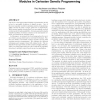Free Online Productivity Tools
i2Speak
i2Symbol
i2OCR
iTex2Img
iWeb2Print
iWeb2Shot
i2Type
iPdf2Split
iPdf2Merge
i2Bopomofo
i2Arabic
i2Style
i2Image
i2PDF
iLatex2Rtf
Sci2ools
GECCO
2008
Springer
2008
Springer
Advanced techniques for the creation and propagation of modules in cartesian genetic programming
The choice of an appropriate hardware representation model is key to successful evolution of digital circuits. One of the most popular models is cartesian genetic programming, which encodes an array of logic gates into a chromosome. While several smaller circuits have been successfully evolved on this model, it lacks scalability. A recent approach towards scalable hardware evolution is based on the automated creation of modules from primitive gates. In this paper, we present two novel approaches for module creation, an age-based and a cone-based technique. Further, we detail a cone-based crossover operator for use with cartesian genetic programming. We evaluate the different techniques and compare them with related work. The results show that age-based module creation is highly effective, while cone-based approaches are only beneficial for regularly structured, multiple output functions such as multipliers. Categories and Subject Descriptors I.2.2 [Artificial Intelligence]: Automa...
| Added | 09 Nov 2010 |
| Updated | 09 Nov 2010 |
| Type | Conference |
| Year | 2008 |
| Where | GECCO |
| Authors | Paul Kaufmann, Marco Platzner |
Comments (0)

